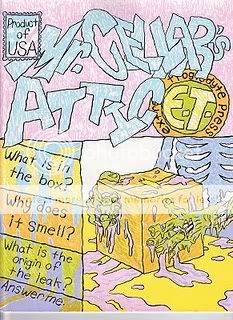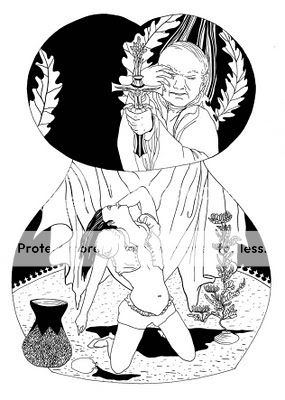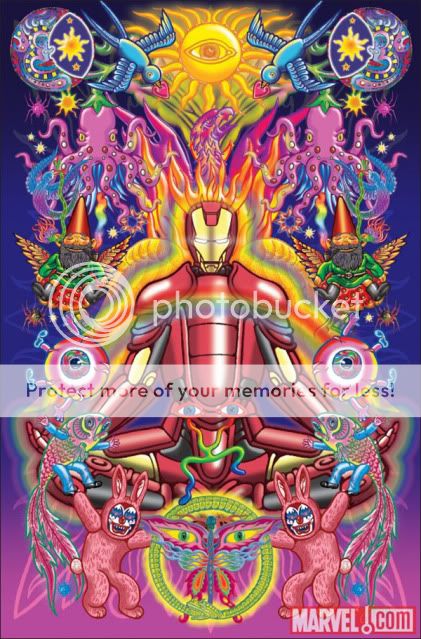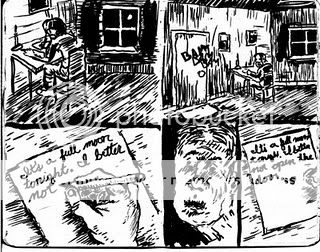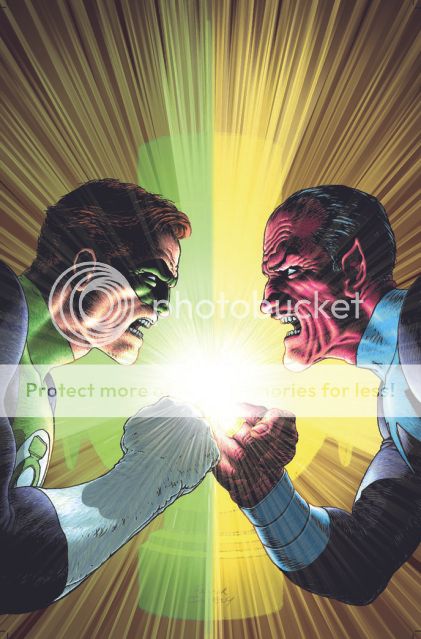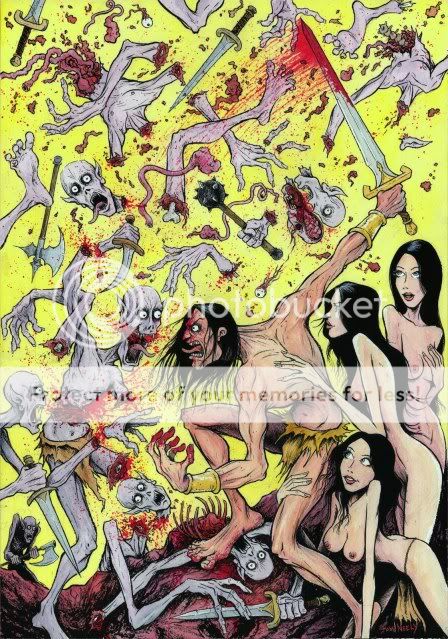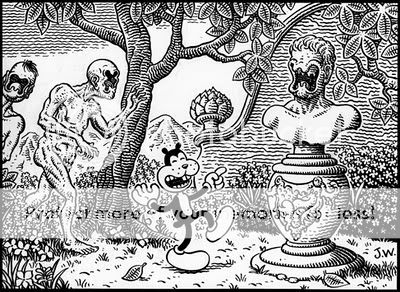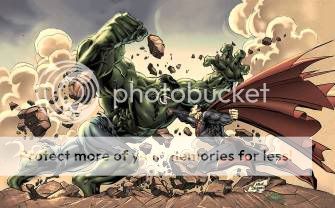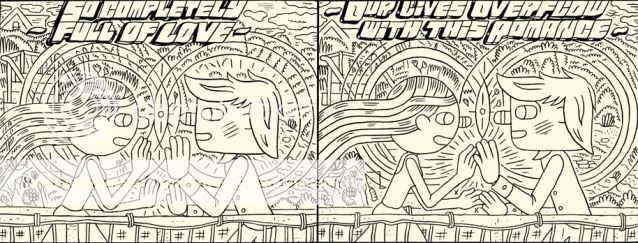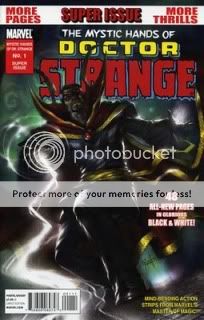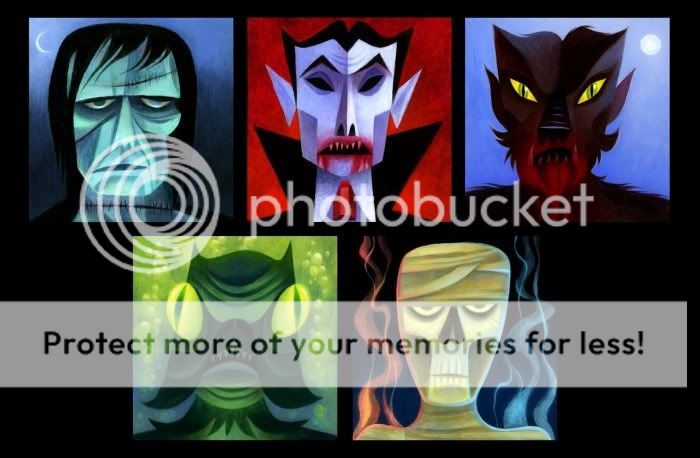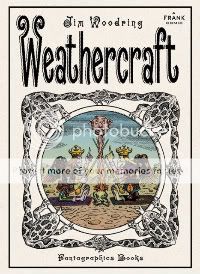Archive for May 31, 2010
Carnival of souls: Special “The Most Eventful Memorial Day Weekend in Nerd History” edition
May 31, 2010* Guillermo del Toro is no longer directing the two Hobbit movies due to its ongoing MGM-related delays playing havoc with his schedule. I’m pretty glad about this, since I thought both Hellboy and Pan’s Labyrinth were bad in just the sort of unimaginatively dingy way that would be really problematic for The Hobbit. (Click the links for my reviews if you want.) But del Toro’s still co-writing the movie with Peter Jackson, Fran Walsh, and Philippa Boyens, which I guess I’m okay with since Tolkien’s original should mitigate against del Toro’s tendency toward lackadaisical plotting. What I really wonder is how much of his art direction will survive into the final product–as you might have guessed, I think his creature work is overrated. Jackson says he’ll step in to direct the movies himself if push comes to shove (via The One Ring), but only then, and he sounds less than thrilled by the idea. Neill Blomkamp, call your agent.
* The Acme Novelty Library #20: Lint: October 12, 2010.
* Here’s the new trailer for Scott Pilgrim vs. the World.
I know Michael Cera comes in for a lot of criticism just for being Michael Cera, but it’s Mary Elizabeth Winstead’s flat-affect Ramona Flowers that’s throwing me for a bit of a loop here. Oh well, it’s just a trailer, I’m sure it’ll be at least pretty good. (Via Shaggy Erwin.)
* Recently on Robot 6: an H.P. Lovecraft art show featuring Johnny Ryan and Aeron Alfrey.
* Deadspin’s “Dead Wrestler of the Week” series by its anonymous wrestling reporter is just plain magnificent. A couple of the earliest installments are a bit rough, but the pieces on Andre the Giant, the Junkyard Dog, and Miss Elizabeth are bleakly insightful elegies, exploring the strange and shady world of pro wrestling and their iconic roles in it. Even a piece on a borderline jobber like Dino Bravo is memorable for what it reveals about how wrestling changed in our lifetimes. And dig this passage from the article on the Ultimate Warrior Is Dead rumor:
As an insurgent, the Ultimate Warrior was irrepressible, but as a champion he was dull. The eccentricity that once made him stand out made him seem dark and bizarre in comparison to the shining light of Hulkamania. When Hogan rallied his little Hulkamaniacs to his cause, it seemed a joyous army; when the Warrior spoke to his “little warriors,” he seemed to be preaching to a cult. If Hogan was the wrestling Billy Graham (the evangelist, that is, not the actual wrestler), the Warrior was Jim Jones.
Man oh man. (Via Eric Harvey.)
* Just curious, and I’m sure some of you actually have the answer: How many times has Jeph Loeb introduced a big new mystery villain, killed off the character everyone suspected as being that mystery villain, then revealed that that character wasn’t really dead and a doppelganger of some sort was involved and the real character was indeed the mystery villain all along? I know he did it in Hush–didn’t he do that in one or two of those Tim Sale Batman books, too?
* Rest in peace, Dennis Hopper. As far as tributes are concerned, I couldn’t find that bit from Land of the Dead where he shoots his assistant in the face, but Matt Zoller Seitz’s 25-minute salute to the man and his career as an actor and director will more than suffice.
Comics Time: Mr. Cellar’s Attic
May 31, 2010Mr. Cellar’s Attic
Noel Freibert, writer/artist
Extreme Troglodyte, April 2010
12 pages
$6
Buy it from Closed Caption Comics
Although that little jpg might get the idea across, you really need to hold the cardstock covers of Closed Caption Comics member Mr. Freibert’s latest horror-comic throwback to see how beautifully screenprinted those colors are. It seriously looks like he sat there and did it by hand with pastel colored pencils. The thinness and shakiness and uniform weight of his linework only further reemphasizes that Mr. Cellar’s Attic was an act of drawing, something that came out of the tip of a pencil or pen held by a person. Which, now that I think of it, is maybe how Freibert is able to reclaim the hoary EC Comics/Edgar Allen Poe/”Colour Out of Space” proto-body-horror tropes he’s working with out of the realm of cliche and make them feel like a force to be reckoned with again. In addition to the cool, clever wordplay of the title, Freibert’s pacing keeps things feeling fresh and lively and present, if you will. There’s an uneasy sense of discovery as Freibert’s guilty-conscienced narrator recounts his ill-fated decision to rent out his attic room to an elderly grotesque, whose personal hygiene and mysterious conduct gets worse and worse until the story culminates with the narrator’s inspection of the room he rented…and the smaller room he built inside it. That’s a great, weird image, and what is found inside that room doesn’t disappoint either. The thing ends with a gorgeously colored shot that all but demands Vincent Price be resurrected to provide his trademark cackle as its soundtrack. If you want a comic that utilizes the tools of today’s artcomix aesthetic to evoke the sensation you got when you were a kid looking at the awesomely hideous masks in the grown-up section of the Halloween store, you know where to look.
Comics Time: Big Questions #14: Title and Deed
May 28, 2010Big Questions #14: Title and Deed
Anders Nilsen, writer/artist
Drawn & Quarterly, May 2010
50 pages
$7.95
Buy it from Drawn & Quarterly
You know how on The Sopranos, it was always the penultimate episode of the season that had the big climax? This is the penultimate issue of Big Questions.
I know I’ve got Lost on the brain this week, and it’s largely with that show in mind that I re-read all 14 issues of Nilsen’s anthropomorphized allegorical avian opus to date. Much more so than do the Vertigo-type series with which you’ll see the occasional facile comparison, Big Questions serves up a similarly intoxicating, dread-tinged cocktail. Flawed characters are buffeted by forces beyond their comprehension, who in turn have just as little control over their own destinies. Violence is ever-present, shocking and exciting when it erupts, devastating in its aftermath. Story seeds planted years ago (Big Questions has been running since 1998!) suddenly blossom, entangle, and collide, in this issue most of all. Of course the “big questions”–about the limits of our understanding, about the point of being here at all–are asked, if rarely answered. An overall high-quality visual presentation makes it all the more inviting, while individual images, like the one that graces this issue’s cover and the constituent parts of the harrowing sequence that precedes it, burn with the fire of the surreal and stick in the memory, giving your thoughts on the overall series something to coalesce around like coral. You’ll laugh, you’ll cry. Only instead of an attractive multinational cast, this one has birds.
My hunch is that when the fifteenth and final issue arrives, Big Questions will be looked at like Black Hole or the Jimmy Corrigan issues of Acme Novelty Library, both for the magnitude of the undertaking and the magnificence of its execution from top to bottom. I read a lot of good comics; this is a great comic.
Carnival of souls
May 27, 2010* Have you pitched in to the Comics Comics fundraiser yet? I snagged myself three issues of Comics Comics, The Art of Hipgnosis and Overspray for a song. I mean, the shipping’s even free. Make sure to buy stuff today, because a lot of the offers are over as of midnight!
* How not to pitch to Secret Acres. I’d imagine this applies to virtually any publisher.
* Rich Juzwiak reveals the Manly Movie classic Over the Top. The phrase “a big fucking bear whose balls you can smell from your couch” is involved. MUST-READ
* Frank Santoro takes you behind the scenes of a drawing of the evil Senator Wastmor.
* I don’t like M.I.A. very much, so maybe it’s just my low expectations for her, but I don’t think this instantly infamous New York Times profile about which she has subsequently flipped out and tweeted the interviewer’s personal cell phone number is all that bad. “Pop Star Says Vapidly Provocative Things, Is a Doofus” is a dog bites man story if ever there was one. Then again, these things are all relative.
Carnival of souls: Special “noteworthy posts” edition
May 26, 2010* There are three things I’ve written recently that have generated some fun discussion so I wanted to make sure to call them all out again, in case you’d like to chip in your two cents:
* On Robot 6 I asked what comics arguments people would like to here more often, in place of the ones we’re all sick of. My suggestion was “Why do superhero comics so dominate the online discussion of comics?” And I’m talking even well-rounded readers/writers who are perfectly capable of talking about other things just as often.
* Also on Robot 6, I asked whether you need to like a character to like the comic about him or her. This stems from Dan Clowes’s Wilson and the focus on the titular jerk’s unlikability. In the comments I start wondering if maybe Wilson’s better seen in the context of comic character-constructions like Laurel & Hardy or Tim & Eric as opposed to your basic fully-fledged well-rounded psychologically complex literary character.
* Finally, here’s a working link to my third post on the Lost finale, which I flubbed yesterday. The discussion is still going strong, which isn’t surprising if the way my own thoughts on the episode fluctuate from day to day and hour to hour is at all indicative of a broader reaction.
* Tom Spurgeon disagrees with Tom Brevoort about the potential risks of the four-dollar monthly comic. Looking at the post in question, I think the Hindenburg comparison is cutting those sentiments a little slack, actually.
* Matt Zoller Seitz and Ali Arikan talk John Williams and his music for the Star Wars prequels, which they consider his masterpiece, with “Duel of the Fates” at the tippy-top. “Duel” is definitely dude at the top of his game decades into his career, if you ask me. To paraphrase Christopher Moltisanti, FUCK Carl Orff, Johnny Williams just took him to composing school.
* Curt Purcell talks Blackest Night again, from its leads to its compartmentalized-by-subgenre structure to its observation of Aristotelian temporal unity.
* Comics, wake up! The call is coming from inside the house! Great line, Heidi.
* Marvel is publishing a comic with this Alan Aldridge image on the cover. Wow.
* ABC is selling official Lost merchandise with these Ty Mattson images on them. Wow.
* It’s only when superhero comics are described by truly disinterested outsiders, as opposed to self-conscious fans or ex-fans, that you realize how truly ridiculous they can be.
* For a second there, I thought Rob Bricken had been replaced by Jason Adams. (Man, that is some Attentiondeficitdisorderly linkblogging inside baseball.)
Comics Time: Held Sinister
May 26, 2010Held Sinister
Conor Stechschulte, writer/artist
Closed Caption Comics, June 2009(?)
32 pages
I don’t remember what I paid for it
I’m coming up empty, but maybe you can buy it from Closed Caption Comics
I’ll tell you what, I wish I could find a link at which you could buy this comic, because if you enjoy the rough-edged alt-art-horror comics I talk about on this blog all the time? Dude, run, don’t walk.
Stechschulte’s art is rough in the extreme, a scribbled mess of thick blacks that nonetheless coheres into something palpable and easy to parse. It reminds me a bit of when I was a kid and I’d scribble one continuous line on a page for a long time, and then go back and highlight the figures and shapes I’d unwittingly drawn in the process. It’s not that manic, but that’s the general idea. It’s a great way to convey claustrophobia and barely contained desperation, which is what our main character experiences as he anticipates and then experiences what is apparently a monthly encounter with a sinister, supernatural visitor–a doppelganger carved from shadow itself. It’s a cool little story, a dark fairy tale or a lost piece of Poe, distinguished by a strong fight sequence, complicating details like the place a body gets stuffed, and a convincing air of inevitability and despair. I wish someone would put together an anthology of horror comics like this. I’d read the shit out of it, and if you care about horror in comics, you would too.
Lost thoughts part three
May 25, 2010My third all-new collection of thoughts about the show and its finale can be found here. Once again, it’s in the middle of a comment thread I think you’ll get a lot out of.
Carnival of souls
May 24, 2010* In less than twelve hours, my post on the Lost finale became the most commented-on post in the history of this blog by a comfortable margin. There are over 50 posts in there, and I claim about one-fiftieth of the credit: The regular crew of Lost watchers who’ve been good enough to do their thing in those Lost thoughts threads week in and week out have created a conversation about the show a million times better than anything I’d ever hoped to find online. Thank you so much, all you participants–and if you haven’t joined in, what better time than now?
* I’ve linked to these posts in the aforementioned thread, but I was pretty taken by some of the thoughts on the episode and the series offered up by Todd VanDerWerff, Alan Sepinwall, and Rob Bricken.
* To that list I’d add Steve Murray/Chip Zdarsky’s magisterial interactive illustration of almost the entire cast of characters. I don’t think he gets any of the women right, but the men are pretty much wall-to-wall impeccable, especially the ones with the craziest or saddest eyes. (Via Kate Beaton.)
* In the sense that last night saw the conclusion of a serialized genre drama I’d been heavily emotionally invested in for almost six years, I couldn’t help but think of George R.R. Martin’s A Song of Ice and Fire, the future installments of which I’ll be waiting for with the proverbial bated breath. Turns out I’m not alone: this is spoilery for the series so be warned, but the GRRM fan site The Tower of the Hand is asking its readers if they’d be okay with a certain loose end remaining forever untied.
* Tom Spurgeon on three comics arguments we could be having instead of all the old, tired, stupid ones. Much more on this anon.
* CRwM spots a passage from C.S. Lewis on fear vs. dread that reads like something H.P. Lovecraft could have written. Sharp stuff from the Don of Narnia.
* That’s some crazy Frank Quitely Green Lantern art. Who colored this thing?
* If Dave Kiersh keeps drawing ’em, I’ll keep linking to ’em.
* If Zak Smith keeps writing ’em, I’ll keep linking to ’em. This one’s on Weird vs. Noir storytelling. Think of the subway episode of Seinfeld when you read it.
* Recently on Robot 6: Tom Neely draws the bloody bejesus out of Conan;
* Jim Woodring draws the bloody bejesus out of whatever the hell the things he’s drawing are;
* and the comics argument I’m interested in having, spinning out of this provocative post by Tom Spurgeon.
Lost thoughts part two
May 24, 2010Click here for further Lost thoughts from me if you’d like. It’s a full-fledged post of its own, right smack-dab in the middle of one of our best comment threads yet.
A spoilery comparison of Lost and Battlestar Galactica
May 24, 2010SPOILER ALERT FOR BOTH SHOWS, SO UNLESS YOU’VE SEEN ALL OF BOTH OF THEM, STAY AWAY IF YOU KNOW WHAT’S GOOD FOR YOU
Okay, you knew this had to happen once you saw what went on in the Lost finale. I came thisclose to promising a separate post on this topic in my Lost thoughts last night, and when I woke up this morning multiple people had already asked me to do so. Like I said, you knew it had to happen.
I think there are two big differences between the two finales, both of which were a mainline hit of mysticism.
First, the mysticism of the Battlestar Galactica finale tied in directly to the show’s central driving conflict and overarching mythology. The “God” we hear about here was the one responsible for such major mystical mysteries as Gaius Baltar’s visions of Six (and Caprica Six’s visions of Gaius Baltar) and Kara Thrace’s strange resurrection, and is the “truth” behind the bowdlerized judgmental monotheism of the Cylons and the more humanistic but still off-model polytheism of the Colonists. In Lost‘s case, while it does seem like the Island is the world’s most direct manifestation of the force for good behind the flashsideways afterlife, that’s a link in a much more general sense. It seems like any group of people who were tied together by anything would have ended up in much the same place; moreover, the Island plot is resolved without requiring any knowledge of the show’s conception of the afterlife, if that makes sense. The afterlife ties things together emotionally, not narratively, whereas in BSG, it’s linked directly to the big plot questions.
The second and more damning thing for Lost is that its conception of spirituality as articulated in that final sequence is awfully banal: The afterlife is a place generated by the force of goodness behind all major religions where you reunite with your loved ones, atone for your sins and shortcomings, and find true happiness before achieving literal enlightenment. Generic New-Age self-help stuff–whoopedy doo! By contrast, the “God” of Battlestar Galactica embraces its own sneer quotes and acts in morally dubious fashion in order to push humanity and cylonity (?) through a series of cycles of genocide and rapprochement for reasons still unknown. The God of BSG is a weird thing whose role in the finale is still haunting and challenging me today, whereas the creators of Lost could have just mailed every viewer a copy of The Celestine Prophecy and been done with it.
Actually, now that I think of it, the God of BSG is a bit like what we thought about “the Island” when we believed it was the source of all the manipulative goings on, before Jacob and the Man in Black entered the picture–a near-omnipotent force that’s probably ultimately a force for what we’d consider “good” but which on the way there does all sorts of heinous shit for reasons we can’t begin to comprehend in the moment.
Finally, I’ve always found it super-stupid to object to genre fiction simply because you discover its conception of the supernatural doesn’t jibe with your own: I read people saying things like “The Exorcist isn’t scary to me because I’m not Catholic” and simply can’t fathom how crazy that is. You don’t find many mackerel-snappers more lapsed than me but I still get the chills when they chant “The power of Christ compels you!” So it’s not like I’ve got beef with Lost for having a relatively upbeat view on spirituality whereas I tend not to. But I do tend not to. I find the atheist/anti-mysticism apoplexy over Lost‘s finale–seriously, people were losing their shit on Twitter–as silly and funny and pathetic and small-minded as I did when it happened at the end of BSG; that said, my hunch is that if there is a God then he’s a lot more like the vast and cool and unsympathetic entity running the show in the BSG universe, or like “the Island” or like a one-man Jacob/Man in Black mash-up. I figured I might as well cop to that.
Comics Time: Snow Time
May 24, 2010Snow Time
Nora Krug, writer/artist
self-published, 2010
12 pages
I don’t remember what it cost, but I remember it wasn’t cheap
How I love little arty morality plays. Hot-shit illustrator Nora Krug follows up her ambitious Red Riding Hood Redux project–probably my big find for MoCCA 2009–with this short, achingly lovely to look at story of weather and murder. Like Red Riding Hood, Snow Time hides some rough stuff beneath its pretty surface, this time around telling the story of a man whose mother’s suicide has left him with dangerous abandonment issues. None of this is made clear until the middle of the story, after which the man’s apparent delight and attention to the snowman he’s built in his front yard in the middle of a weeks-long spate of snowstorms takes on a new (albeit only implied) punchline quality, and it’s a refreshingly chilling one. (Pun intended, but seriously, the image it implies through one quick panel of the snowman melting is sticking with me.) Snow Time is also an exercise in getting rich, sumptuous green-blues and manila-yellows to not just sit on a page, but radiate off of it, the way you can feel cold coming off of something metal. It ends with a tableau of grim discovery that reminds me of Taxi Driver of all things. It was worth the coin.
Lost thoughts
May 23, 2010SPOILERS SPOILERS SPOILERS SPOILERS SPOILERS SPOILERS SPOILERS SPOILERS SPOILERS SPOILERS SPOILERS SPOILERS SPOILERS SPOILERS SPOILERS SPOILERS SPOILERS SPOILERS SPOILERS SPOILERS SPOILERS SPOILERS SPOILERS
* Hmmm, I dunno. Honestly I had to take my cat to the emergency vet tonight and that situation is far from resolved so I don’t know if my head’s in the game, really. I do have two major thoughts.
* I think the main thing I haven’t wrapped my head around just yet is the disconnect between the flashsideways and its resolution and anything having to do with the Island. I mean, yeah, on a certain level that stained glass window is telling us that the Island is connected with whatever spiritual whatsit is in charge of whatever afterlife they went to. But it’s not a specific connection as best I can tell. It’s sort of like, I don’t know, if at the end of…I don’t know, Road House? If Dalton defeated Wesley and saves the town and avenges Wade Garrett and all that stuff, and then also he goes to Heaven. Like, the actual resolution of the show doesn’t really have anything to do with the resolution of the plot. So I’m gonna have to wrestle with that some.
* I don’t really mind, in the end, all the loose ends. I never thought I’d mind the various dotted-I crossed-T loose ends like who shot at the kayak. And I’ll live without some of the “we thought this was gonna be a big deal in the early seasons but then we went in a different direction” loose ends like WAAAAAAAAALT!!!!! I’m not thrilled, but I’ll live. But what I’m really okay with is just how much is an out-and-out mystery. Why did Ben and Widmore have their falling out? Why was Dogen so important? How did the Monster swoop in to manipulate the Others without Jacob stopping it> When the hell did the Island get overrun by Egyptian architects? How long was Mother around? Et cetera et cetera et cetera. I am pretty much fine with not having any idea but what I myself can deduce and infer and other words of that nature. I totally don’t mind looking at the show like you looked at the Star Wars franchise after Return of the Jedi. What were the Clone Wars? How did Yoda train Obi-Wan? Why did Darth Vader turn on the Jedi? Where’d the Emperor come from? What was up with Boba Fett? Folks, are you better off knowing those answers?
Lost thoughts roundup
May 23, 2010Below are links to all my Lost posts. Enjoy!
Episode 5.1: Because You Left/Episode 5.2: The Lie
Episode 5.3: Jughead
Episode 5.4: The Little Prince
Episode 5.5: This Place Is Death
Episode 5.6: 316
Episode 5.7: The Life and Death of Jeremy Bentham
Episode 5.8: LaFleur [part one]
LaFleur [part two]
Episode 5.9: Namaste
Lost thoughts extra: “…and the rest”
Episode 5.10: He’s Our You
Lost thoughts extra: Ben time
Episode 5.11: Whatever Happened, Happened
Episode 5.12: Dead Is Dead
Episode 5.13: Some Like It Hoth
Episode 5.14: The Variable
Episode 5.15: Follow the Leader [part one]
Follow the Leader [part two]
Episode 5.16: The Incident
Flashback: The First Five Episodes
Episode 6.1-2: LA X [part one]
LA X [part two]
LA X [part three]
Episode 6.3: What Kate Does
Episode 6.4: The Substitute [part one]
The Subsitute [part two]
Episode 6.5: Lighthouse [part one]
Lighthouse [part two]
Episode 6.6: Sundown
Episode 6.7: Dr. Linus
Episode 6.8: Recon
Episode 6.9: Ab Aeterno
Episode 6.10: The Package
Episode 6.11: Happily Ever After
Episode 6.12: Everybody Loves Hugo
Episode 6.13: The Last Recruit
Episode 6.14: The Candidate
Episode 6.15: Across the Sea
Episode 6.16: What They Died For
Episode 6.17: The End [part one]
The End, bonus thoughts
The End, part two
The End, part three
The End, revisited
Thought of the day
May 23, 2010I would love, love, love to see a Hulk vs. Superman fight done with the intensity of that fight from Deadwood. You know the one.
(Via Tom Spurgeon.)
Carnival of souls
May 21, 2010* Zak Smith ought to be making all fantastic-fiction writers raise their respective games.
* Ron Rege Jr. joins What Things Do! And with one of the better Ron Rege Jr. comics you’re likely to see.
* More like this, please, Dave Kiersh!
* Another new Josh Simmons comic!
* Cute idea. Would have been cuter if they’d gotten A-listers to do all of them instead of admitted rush-jobs, but still cute.
* Real-Life Horror: Bagram is the new Guantanamo.
* Okay Internet, you’re definitely right about this one.
* Finally, this is your last chance ever to join our weekly Lost thoughts discussion and speculate about what might happen next; after Sunday night, there are no more nexts. Please stop by then, too, and we’ll hash out the whole damn series together!
Comics Time: The Mystic Hands of Doctor Strange #1
May 21, 2010The Mystic Hands of Doctor Strange #1
Keiron Gillen, Peter Milligan, Ted McKeever, Mike Carey, writers
Frazer Irving, Frank Brunner, Ted McKeever, Marcos Martin, artists
Marvel, March 2010
48 pages
$3.99
I’ve read enough Hellblazer to understand the appeal of an anthology-style series of self-contained stories about a sorcerer jumping ugly with the dark supernatural and coming out on top, but at a price. John Constantine himself, though, is not for me. The spiked hair and stubble and cigarettes, the rumpled trenchcoat and English curses…obviously that’s cool with a capital C for many people, but it’s just not a set of character descriptors I can get terribly invested in. I think my favorite Hellblazer stuff I’ve ever read was a Jamie Delano thing back when he had longish wavy hair and spent the arc in jeans and a clean white t-shirt.
Doctor Strange, on the other hand? Oh yes indeed. People like NeilAlien and Tom Spurgeon have made much more convincing cases on behalf of the once and (hopefully) future Master of the Mystic Arts than I could ever do, but I’ll simply say that he’s a collection of images and ideas that I really like when they’re all smushed together. I like his big high-collared cloak, the Eye of Agamotto, his goatee/gray-temples combo, his Steve Ditko hands and Steve Ditko psychedelic vistas, his Greenwich Village lair that’s got more mysterious rooms than you’d find in its official floorplan, his pal Wong, his origin as the world’s biggest dickhead who suddenly realizes what a worthless tool he is when his hands get broken in a car wreck and he can no longer be a hot-shit surgeon, his vision quest in the Himalayas, his gorgeously designed enemies like Dormammu and the Mindless Ones, the idea that he’s constantly fighting against so many massive threats that neither the other heroes nor civilians could ever possibly appreciate the magnitude of his gig, all those great gibberish names and epithets Stan Lee cooked up for him to invoke, his highfalutin speech pattern derived from years of study of the most esoteric subjects imaginable, and on and on and on. I understand why the strictures of Marvel’s publishing model with respect to its superheroes probably prevents this, but a largely continuity-free solo Doctor Strange series in the vein of Hellblazer? I bet a small but loyal audience would be there for every issue, in large part because a large and loyal number of writers would love to sweep in for an issue or an arc and tell the one Doctor Strange story they’d always dreamed of telling, and an equal number of artists would wanna give their Ditko chops a major workout. I’d be there with ’em.
And lookee here! One of a series of pulpy ’70s-style black-and-white one-shot anthologies featuring stories about some of Marvel’s rough’n’readier characters (we’ve also seen War Machine and Ares), The Mystic Hands of Doctor Strange is (wait for it) just what the Doctor ordered. I was entertained as the dickens by all four tales contained herein, for all the reasons I enumerated above.
I think my favorite take on Strange here comes from Kieron Gillen in the story that kicks off the book. Sure, it doesn’t hurt that he’s working with the awe-inspiring Frazer Irving, who was born to draw Doctor Strange’s world. (He was also born to work in color, and you can feel him wanting to–for god’s sake it’s a Doctor Strange story set in the hippie era–but I’ll take what I can get.) But I was intrigued by Gillen’s conception of magic as a sort of cosmic whodunit, where when something’s going down, the Doc must figure out who had the means, motive, and opportunity to do it…in an arena where none of the rules of cause and effect, physics, or human behavior with which we are familiar are necessarily operative. In both the Gillen/Irving and Milligan/Brunner stories, there’s a final twist that emphasizes Strange’s self-martyrdom, his willingness, whether through necessity or weakness, to do some bad thing that will hurt him to get the job done. It’s really only he who gets hurt in the process, though, which is what separates him from your run-of-the-mill anti-heroes. When the Sorcerer Supreme crosses a line, he’s the only collateral damage. That’s what makes him the Sorcerer freakin’ Supreme, you know?
While the first two stories are period pieces set in the same timeframe as the publication of Marvel’s original black-and-white magazines, the second two are different. Ted McKeever’s one-man showcase of scratchy, angular blacks and weirdo creature designs–yep, that’s our Ted!–is a timeless tale, in which a devastated Doctor Strange roaming around on an alcoholic bender nevertheless encounters a demon and a benevolent spirit and learns an important lesson about his sorcery…which is exactly the kind of thing that should happen to a Sorcerer Supreme on an alcoholic bender. (I like to believe he’s discovering hidden knowledge when he’s on the shitter, even.) The final story is a short prose piece by Mike Carey in the style of an early 20th century weird adventure, featuring an impressively evocative Frazetta Death Dealer-style antagonist, a simplistic but effective take on mind over matter, a grin-inducing tease of Doc’s archenemy, and a pair of killer spot illos from Marcos Martin, including one that’s almost Paul Pope-ish in its riotous kinetic energy.
All told, it’s as an effective a disquisition on what makes Doctor Strange worth making comics about since Martin and Brian K. Vaughan’s memorable miniseries The Oath–perhaps even moreso, since while that series was clearly an attempt to say “See? Doctor Strange still works!”, this one-shot feels like it was constructed with that basic proposition never once in doubt. I got from it precisely the modest but indubitably pleasurable pleasure I wanted. More like this, please.
Carnival of souls
May 20, 2010* Go support Team Comics Comics!
* It’s an interview with Grant Morrison. Money quote:
I tend to only read comics written by friends or people I’ve known. And I’m not a great comic reader. I get a bunch of DC stuff sent in a box every month, and I’ve got a friend in town who runs a store, and he gives me stuff every now and again. But I’m not a big comic reader, so I tend to read people like Warren Ellis or Alan Moore. People I’m familiar with, or that I’ve met, or that I’m friendly with. Like Mark Millar or whoever. It’s more on the basis of who I know rather than who I like.
(Via JK Parkin.)
* I’m actually dreading the conclusion of Anders Nilsen’s Big Questions. I’m not sure if I’ll be able to handle it.
* Hey, wanna by some pages from Ron Rege Jr.’s masterpiece Skibber Bee Bye? (Via Tom Devlin.)
* It’d be relatively easy to believe that the notion that comic shops with creepy stuff on display or creepy people in their employ are a barrier to female readers was some kind of Comic Shop Guy-style self-loathing comics-community stereotype, but no, it’s true, they’re a barrier to female readers as Hope Larson’s survey of some of them confirms. My wife and I haven’t gone to many comic shops together, but I can tell you that the creepy one–the defunct Village Comics–is the only one she ever talks about. Bad impressions last, and a few topless Nazi women in a display case at the checkout counter can go a long way toward making someone never want to visit any comic shop again. (Via Tom Spurgeon.)
* This Ken Parille piece on monologues, soliloquies, and thought balloons vs. speech balloons in Daniel Clowes’s Wilson is really worth considering when reading that book.
* Topless Robot’s Merrill Hagan returns to the Disturbing Moments in Kids’ Movies well with predictably unsettling results. Points of interest: The Flying Monkeys get their due; “Remember me, Eddie? When I killed your brother?” beats the death of the squeaky shoe; at least one moment cited is genuinely emotionally devastating rather than just scary (“Arthax, you’re sinking!”); and Jesus Christ, that scene from Superman III where the lady gets sucked into the computer and turned into a cyborg is like something out of Hellbound: Hellraiser II. That scene scared me so badly as a little kid I wouldn’t go into the TV room alone in case the TV switched on by itself and showed me that scene again.
* It’s like “Xanadu” meets corpse paint meets vampires meets the video for “Call On Me” by Eric Prydz. Goldfrapp are great.
Carnival of souls
May 19, 2010* “Likable characters are for weak-minded narcissists.”–Daniel Clowes. That quote just really needed to be present on this blog. (Hat tip: Matthew Perpetua.)
* Frank Miller is totally blogging on a regular basis. That’s so awesome. I can’t find an RSS feed but there’s gotta be one, right? (Via JK Parkin.)
* Recently on Robot 6:
* and the comics arguments you never want to hear again. So far, I think I agree with the listing of almost every such argument in the comment thread.
* Am I crazy to think that the guy suing Heroes for ripping off his dopey comic may have a case?
* Now that’s shelf porn. I think the most entertaining shelf porn is the sort where you can’t imagine living the life that would lead you to compile this particular shelf-porn configuration but find it hugely impressive nonetheless; that’s certainly the case for me here.
* I can’t really imagine that anyone reading this blog has any interest in the music of Eric Whitacre, and it’s not like I’m gonna front and say I know a whole lot about contemporary choral music–my knowledge and fandom begins and ends with Whitacre and Morten Lauridsen–but the guy is stupid talented and makes the most heartrendingly beautiful music I’ve ever heard. He’s forming his own ensemble and recording a complete choral works album with them, which is terrific news and will serve as a great gateway into his stuff for interested parties beginning this autumn. In the meantime, I think you can listen to everything he ever wrote on his site; start with “Lux Aurumque.”
* Speaking of music, boy, did I ever need this new Underworld song.
Gossip Girl thoughts
May 19, 2010Back by popular demand! SPOILERS for Monday’s season finale, so watch out.
* I stopped writing about Gossip Girl after it returned for its third season’s back half because, frankly, I was a lot less entertained by it. First off, I hate to be one of those people who turns against a show when it’s not even on, but I think that endless hiatus between the two halves of the season really hurt the show’s momentum in and hold on my mind, if not the larger pop-cultural hivemind too. The thing about Gossip Girl is that it works in, what, three-episode arcs? So unless you’re super-invested in whatever cliffhangers you have before a hiatus, it’s not like there’s some over-arching narrative that will pull you back in when it comes back.
* My biggest problem with this season is easy to pinpoint: The constant, purposeless lying by everyone to everyone about everything. Who slept where, who’s going to what party, who’s applying to what school, who’s sick, who’s healthy, who’s having an affair, who’s in town, who’s out of town, who’s a long-lost parent, everything, all the time. And since every lie is inevitably exposed within two episodes of its initial utterance, it’s all so pointless! I joked to a friend that you could replace pretty much every script this season with the sentence “Look, I was gonna tell you…” It’s simply impossible to get very invested in characters who lie all the time, to the people they love, about things they easily could have–and ought to have–told the truth, with ultimately no payoff for having lied.
* It didn’t help that in service to this constant-lying pattern, Serena and Jenny in particular became almost unwatchable. I don’t think it’s a coincidence that the two of them were put in more and more revealing clothing as the season went on: Without Blake Lively’s thighs and Taylor Momsen’s jailbait cleavage, I think most viewers would have just checked their email every time those two amoral idiots were on screen. It’s not so much the amoral part that irks–on a show starring Chuck Bass and Blair Waldorf, how could it be–it’s the idiocy. The dopey duo’s backing of Serena’s evil deadbeat dad’s play to break up Lily and Rufus was the icing on the cake of a season’s worth of moronic decisions that constantly hurt the people they cared about for no good reason.
* A related problem is how repetitive the show got. When your M.O. is “Have Character A lie to their significant other Character B about Life-Goal X,” that’s bound to happen. But even in terms of the specifics, this season saw two long-lost parents return to the lives of two characters, only for them to discover they had ulterior motives, only for us to discover these people had hearts of gold way down deep anyway, only for them to leave Manhattan. That’s an awfully weird well to draw from twice in one season.
* But I have to give the finale props, since it basically dropped a neutron bomb on the unsatisfactory status quo. Serena breaks up with Nate, and good riddance because she doesn’t deserve him. (Look at that guy, he’s a god walking among mortals.) Jenny’s reign of dumb terror is over and she’s off to the sticks, Serena’s sophomore year style. Dan’s ready to ditch the insufferable Vanessa and their joyless relationship, which started in a threesome with a movie star and quickly devolved into constant attempts to undermine one another’s college career, for another shot at being Serena’s human legwarmer. Nate’s playing Dick Grayson to Chuck’s time-lost Bruce Wayne, inheriting the Mantle of the Bass. Blair and Serena are off in Paris, mutually free of commitments for the first time, which really is just as cool as they seem to think it is. Lily and Rufus seem okay, and I’m glad because enough drama between those two already. Georgina and her amazing changing haircolor are pregnant, probably not with Dan’s lovechild but whatever, we can play along for the episode and a half tops it’ll take them to reveal he’s not the daddy. Chuck gets gunned down in Crime Alley, surely soon to be born again as the billionaire crimefighter he already more or less became this episode. Eric remains adorable and decent, and because he’s a young gay man he’s never going to get any on-screen action.
* So, I guess the whole sexual-assault thing is forgiven and forgotten, huh, Jenny? I’m actually a little disappointed in Chuck’s deflowering of Jenny. I know they were both supposed to be totally depressed and miserable at the time, but it would have been extra-delightfully perverse if they’d, you know, enjoyed it.
* That and the bogus gunshot/pregnancy cliffhanger’s aside, it was a fine clearing of the decks, with some fun, intense, ultra-dramatic confrontations and hook-ups and break-ups. It’s sort of like Gossip Girl Season Three Part Two was “Dark Reign,” the finale was Siege (with better fight choreography), and now hopefully Season Four will be the Heroic Age.
Comics Time: Weathercraft
May 19, 2010Weathercraft
Jim Woodring, writer/artist
Fantagraphics, April 2010
104 pages, hardcover
$19.99
Wow. And you thought Wilson was mean-spirited!
Part theater of cruelty, part joyous liberating revolution, Jim Woodring’s freakishly beautiful Weathercraft is at once the most direct and most elliptical of his Frank comics that I can remember reading. In its pages, Manhog, the half-human half-pig character who’s the Frank-verse’s avatar for the physical side of the id in the same way that funny-animal Frank represents consequences-be-damned curiosity and leisure, is made to physically suffer like you’ve seen few comic-book characters suffer before. Yet due to circumstances just as beyond his control as the passion he’s put through, this trauma leads him to an enlightenment that defies the spacetime continuum as he channels his newfound understanding into righting wrongs small and large. Yes, the cosmic reset button is hit at the end–this is a Frank comic after all, and it needs must remain static just as the Krazy/Ignatz/Offisa Pup triangle does. But until then, you’ve got a comic that’s both so confrontationally visceral and brutal that I almost put it down a couple of times, and one that’s such a visual and narrative strange-geometry dodecahedron that I compulsively read all the jacket copy upon finishing the comic just to make sure I had the first clue what the hell had just happened.
I think perhaps the most underrated weapon in Woodring’s artistic arsenal–certainly the one that had the greatest and most unexpected impact on me in this book–is, of all things, his panel borders. As you picture a Woodring Frank comic in your head, you’re probably seeing those wavy, buzzy lines that comprise his backgrounds, looking like a mosquito in your ear sounds; or perhaps those overripe plant-animal-mushroom-deity hybrid visuals, which explode the narrative at regular intervals. Unless you were paying specific attention to them, my guess is that if you were asked to describe Woodring’s panels, you’d say they were wavy themselves, maybe even prone to the baroque. But lo and behold, they are rigorously ruled rectangles and squares; on any given page, their borders are the thickest line to be found. I know I’ve written in the past that the presence of panel borders makes it difficult for comic horror to infect your nightmares; I still think that’s true, but in the moment, they can have–as they do here–an almost subliminal effect on your reading experience. No matter how woozily psychedelic each image here is, those big thick blocks tell you that something heavy is happening, something scary and indelible. Even in a Frank story; even in a Frank story where the characters’ nemesis Whim–that evil grinning guy who looks like a cross between Old Scratch and the moon-faced guy from those old McDonald’s commercials–reveals his all-powerful true self like the Sentry in Siege #3 and melts the reality of his enemies; hell, even in a Frank story in which a pair of new characters who look like something out of Stephen King’s Dark Tower series play Dark Tower-style games with the very fabric of their fictional world’s reality–even in stories like those, those panel borders communicate “Not a hoax! Not a dream! Not an imaginary story!” It makes Manhog’s torment all the more awful, and his triumph, however fleeting, all the more awesome.


